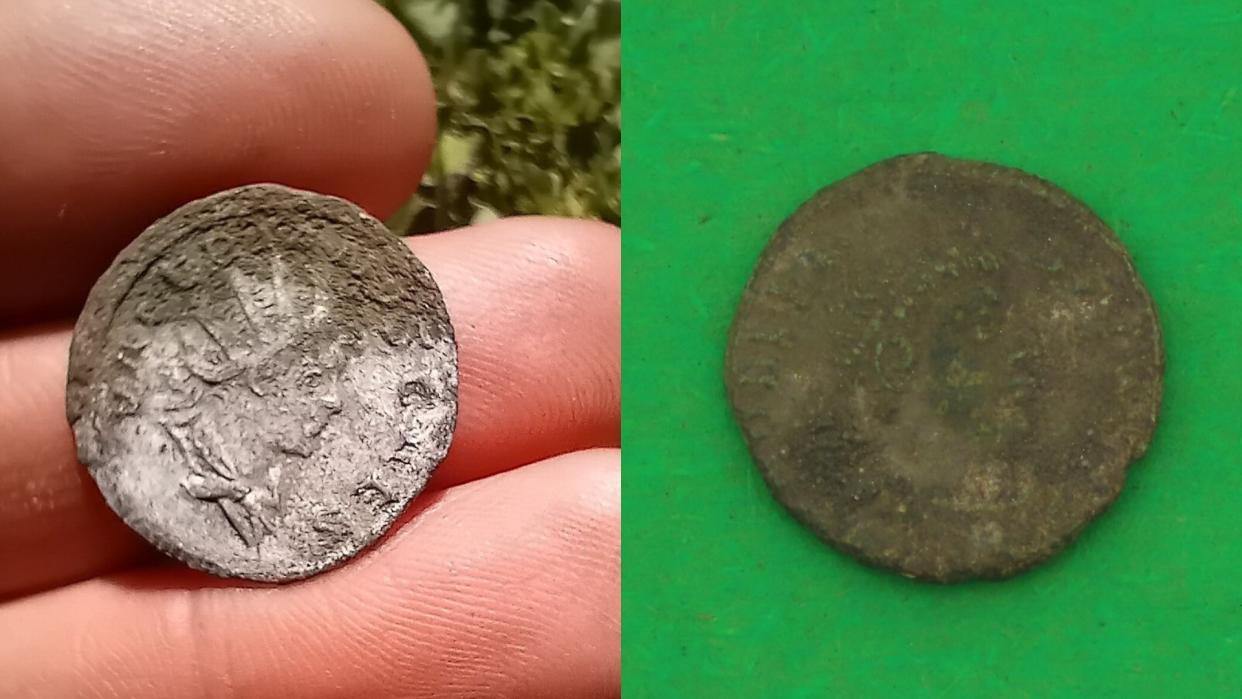1,600-year-old coin discovered in Channel Islands features Roman emperor killed by invading Goths

- Oops!Something went wrong.Please try again later.
- Oops!Something went wrong.Please try again later.
- Oops!Something went wrong.Please try again later.
Archaeologists in the Channel Islands off the coast of France have discovered two Roman coins — one featuring a caesar who was "bumped off" as a teenager and another depicting a Roman emperor who was killed by invading Goths.
The discovery of the coins and previous findings of Roman structures, including the remains of a fort, suggest that the Romans had set up shop on the small island of Alderney, the northernmost Channel Island.
"We're starting to think that the Romans were here to keep an eye on that little stretch of water between here and France," Jason Monaghan, an archaeologist with the excavation and secretary of Dig Alderney, a charity for archaeology on the island, told Live Science. "The ships coming up from the Mediterranean carrying cargo and oil and wine and things like that would have had to pass Alderney, so the Romans probably put a fort there in order to keep an eye on that trade route to stop pirates and things of that nature."
Archaeologists have been excavating at Alderney since 2008, but there's still more to uncover, Monaghan said. In 2017, electrical workers discovered Iron Age burials and parts of a Roman building, showing that humans have occupied the island for thousands of years, he said.
An excavation of the Roman-era building revealed that it had three rooms, a courtyard on one side, a paved area on the other and a garbage dump to the southeast. One of the coins was found in this dump: A silver coin, known as an "antoninianus" that dates to A.D. 255 and was worth two denarii, a standard silver coin minted during the Roman era. The coin features the bust of Valerian II — the grandson of Roman emperor Valerian, who named his son co-emperor and his teenage grandson caesar. However, Valerian II wasn't long for this world; he died two years later under suspicious circumstances.
Related: Mystery of Roman coins discovered on shipwreck island has archaeologists baffled
The coin of Valerian II is "a little bit bigger than my thumbnail," Monaghan said. "It's quite thin. It's got the head of the caesar, he was like an assistant emperor, and he was only a teenager at the time. He was bumped off a couple of years later."
Monaghan noted that because the Roman Empire had a lot of inflation during this period, they were "diluting their coinage," so the coin isn't solid silver.
RELATED STORIES
—Rare gold coin found in Hungary shows assassinated Roman emperor
—Ancient hoard of gold Roman coins discovered in plowed UK field
—More than 3,000 Roman coins and gems unearthed at 'magical place' in northern Italy
In later layers of the building, archaeologists found the other coin — a bronze of Roman co-emperor Valens dating to between A.D. 364 and 367. Valens was famously killed by the invading Goths at the Battle of Adrianople in what is now Turkey.
"It's quite a low-value coin from towards the end of the Roman Empire in the West," Monaghan said. "They're quite muddy, these bronzes — they're not very well struck."
About 90 feet (27 meters) away from the building are the remains of a Roman fort. "The Valens coin is from about the same date as the Roman fort was built," Monaghan said. It's not known who else lived on the island besides the fort's soldiers, but it's possible their families or government officials also lived there. So, it's unclear how the building was used, but there are likely more Roman-era buildings now buried across the island's sand dunes.
"It's like a mini Pompeii down there," Monaghan said.
As for the Iron Age site, archaeologists have found several human remains in a "very rich" burial ground, he added.
Editor's note: This article was updated at 3:22 p.m. EDT to fix the location of Alderney, which is in the English Channel off the coast of France.

